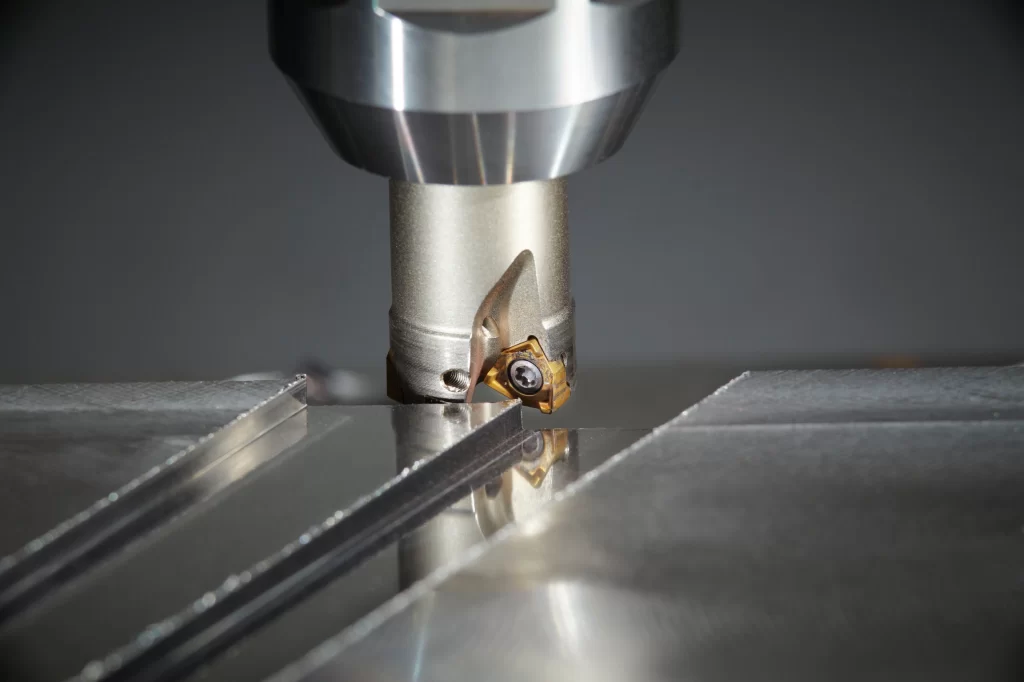
Shoulder Milling Cutter
Shoulder milling is a process of machining the material to assemble the vertical parts on horizontal surfaces of different products. Complex profiles and accurate 90° shoulders are frequently difficult for manufacturers in the automotive, aerospace, and medical sectors. Dimensional errors, tool wear, and expensive rework can result from improper milling procedures. This is achieved through shoulder milling, which enables precise vertical-to-horizontal part connections.
Shoulder milling ensures precision in making the shapes suitable to fit the vertical parts and enhances the performance. It is useful in the aerospace, automotive, and general manufacturing industries.
The working principle, applications, cutters (such as square shoulder milling cutters), and role of shoulder milling in modern CNC milling services are all covered in this guide. Engineers and decision-makers can choose the best machining technique for high-precision parts by being aware of this process. So let’s begin:
What Is Shoulder Milling?
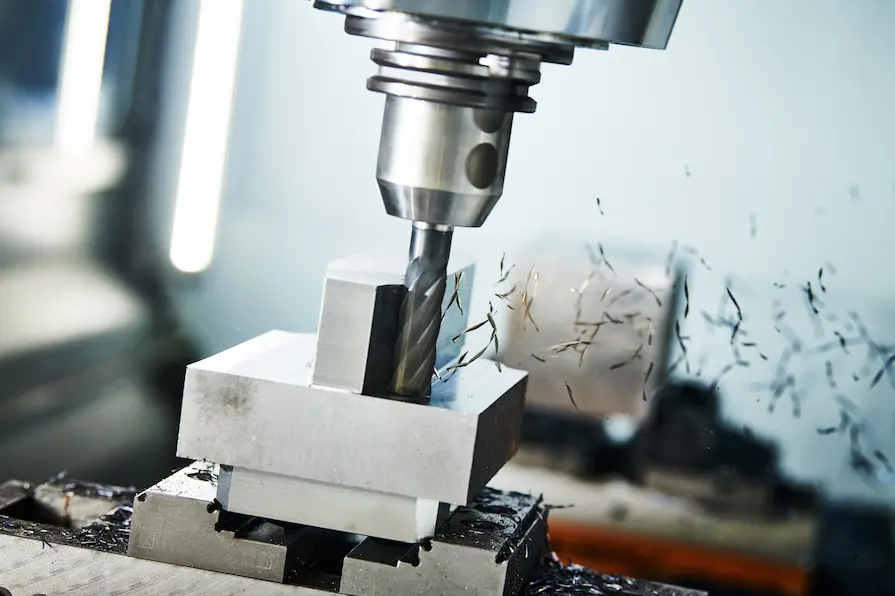
Shoulder Milling
Shoulder milling is the machining process that cuts the material along the edges or sides of a workpiece. It is primarily used to form the shoulders to attach the vertical surfaces to the flat horizontal parts. This operation makes sure the accuracy of the angle, i.e, 90 degrees between two surfaces to be joined.
It is commonly performed by different types of milling cutters, like side milling cutters or end cutters, that move along the edges. Shoulder milling is important in manufacturing the parts where shoulders with grooves are required.
What Is Shoulder Milling Used For?
Shoulder milling plays a significant role in giving the shape to the parts where clean geometry and accurate edges are required. It is used to make shoulders on flat and smooth surfaces. It takes a lot of care in terms of accuracy and precision of dimensions.
Once the material is milled, both parts are assembled together. It results in the finished high-performance products.
How Does the Shoulder Milling Process Work?
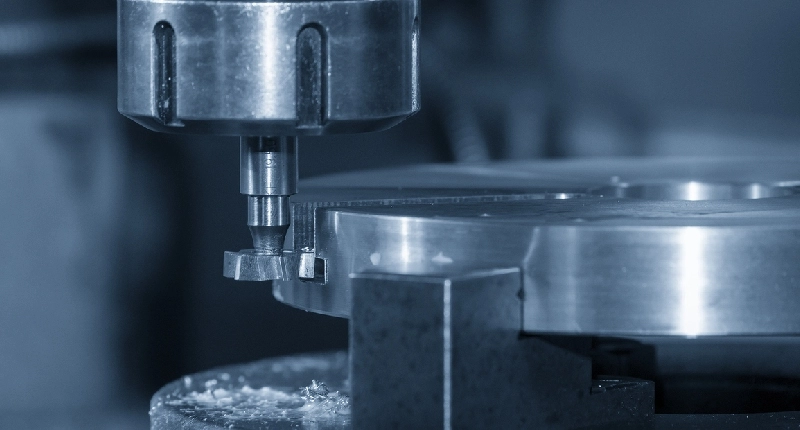
Shoulder Milling Process
Shoulder milling is done by using rotating milling bits or cutters. These tools move on the flat side of a horizontal surface.The cutter has several cutting edges of steel or carbide for a speedy cutting process.
During the milling process, the workpiece is fastened to the table. The milling cutter is held with the help of an arbor, which is connected to the milling machine. The cutter rotates and cuts the material and slices from the edges. Some coolants are used to cool down the heat during the cutting. It also protects the tool from wear and tear, especially when dealing with hard materials.
It can be milled in other forms, such as side milling, up-milling, and down-milling. Side milling provides flat surfaces, slots, keyways, or any other features. In up-milling, the cutter turns opposite to the feed, causing more friction, tool wear, and a rougher finish. In down-milling, the cutter turns in the same direction as the feed, giving a smoother finish and less tool wear but requiring rigid clamping.
How Does Shoulder Milling Differ From Other Types of Milling?
Shoulder milling is different from other types of milling in terms of its approach, cutting tools, and further end applications. When we compare it with traditional milling types such as face milling and end milling, shoulder milling holds its own separate place and importance.
Face milling is used to flatten the surface and specifically operates on horizontal surfaces, while shoulder milling cutters work on the sides and edges of the workpiece.
Unlike face milling, which primarily works on flat surfaces, end mills are multipurpose tools that can cut a workpiece’s bottom and vertical walls, making them appropriate for creating shoulders, slots, and grooves.
Hence, whether it is face mill vs end mill, shoulder milling is as important as other types.
What Industries Typically Use Shoulder Milling
Shoulder milling has been extensively employed in industries that need accuracy and efficiency in shaping metal or other materials.
It is applied in the aerospace industry to produce more complex components such as engine parts and airframes, where fine finishes and tolerances are important. It is used in the automotive industry to manufacture engine blocks, transmission components, and other essential parts.
Shoulder milling is used in mold and die-making industries to create accurate molds in which the product is to be cast and formed. It is used by medical device manufacturers to design complex implants, surgical devices, and prosthetic components. It is also used by heavy machinery makers in gears, shafts, and housings.
Try Prolean Now!
What Are the Types of Shoulder Milling Cutters?
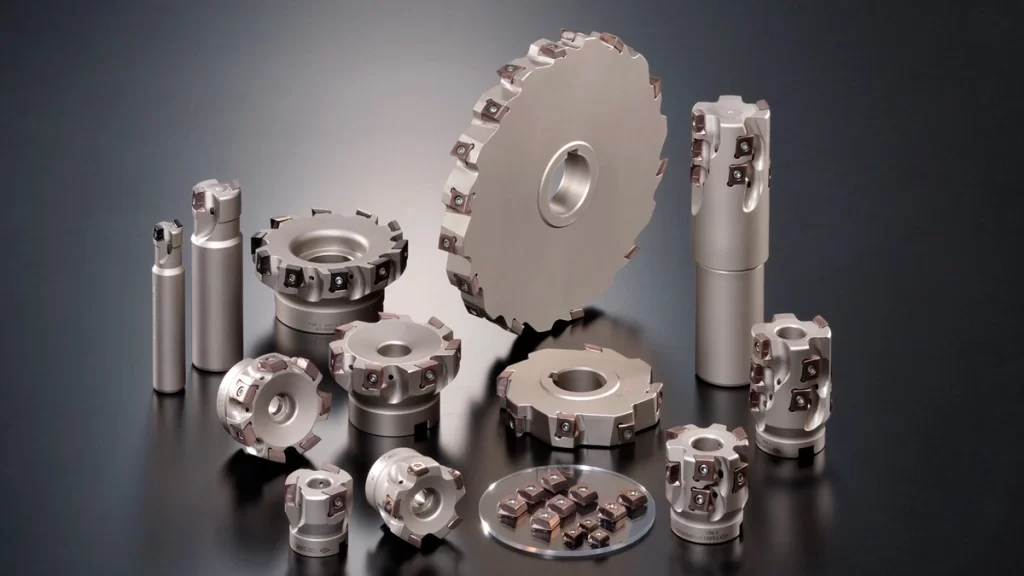
Types of Shoulder Milling Cutters
Some important and most commonly used shoulder milling cutters are listed below. Each one of them is designed for a special purpose and material.
End Milling Cutter
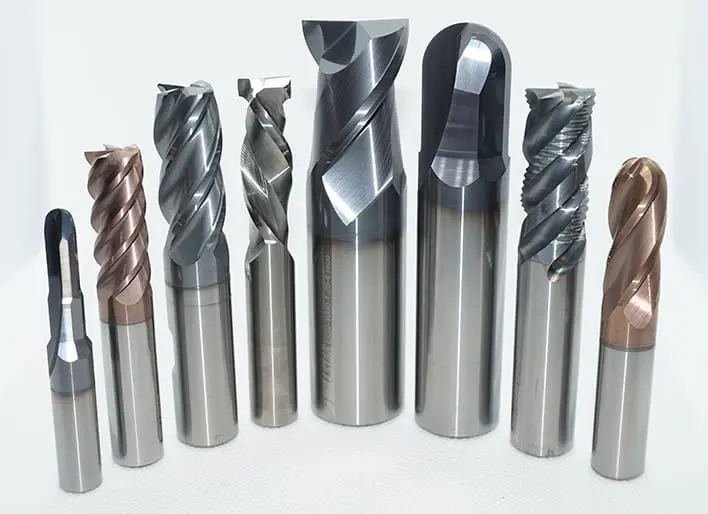
End Milling Cutters
An end mill is a cutting tool that can cut in many directions since it has teeth at the end as well as the sides of the cylinder. It works with metals, plastics, and wood. It is best used to make grooves, slots, contours, and complex 3D shapes. In CNC milling, end mills are commonly used to make accurate and detailed designs.
Face Milling Cutters
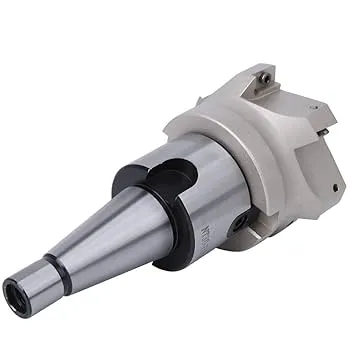
Face Mill Cutter
Face milling cutters are used to cut material off flat surfaces. They rotate on replaceable inserts with several cutting edges that form smooth and even surfaces. They are applied in aerospace, automotive, and general manufacturing industries to provide a flat and precise cut.
Solid Carbide Cutters
These cutters are made entirely out of carbide and are very hard and heat-resistant. They give accurate cutting on metals such as steel, aluminum, and composite. Precision CNC milling of engine components, dies, woodworking, and medical devices uses solid carbide cutters because of their longevity and precision.
Indexable Milling Cutter
Indexable cutters can also be used with replaceable inserts that can either be swapped or rotated to keep the cutting edge sharp. They are flexible, cheap, and are applied in activities such as face milling, slotting, and profiling. This saves time and improves efficiency in production.
Square Shoulder Milling Cutters
These are square cutters with numerous indexable inserts that are powerful and stable when milling at high speeds. They are employed to produce accurate 90-degree shoulders, slots, and flat-bottomed cavities. Square shoulder cutters can be used with metals, plastics, and composites, and are applicable to rough and finish milling in aerospace, automotive, and general manufacturing industries.
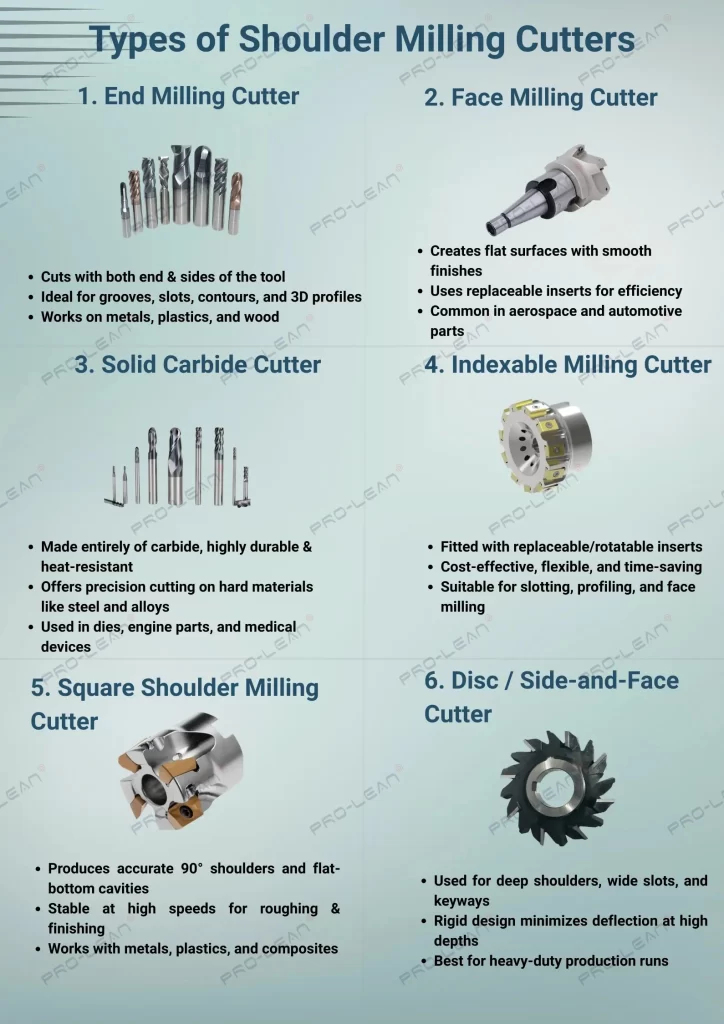
Types of Shoulder Milling Cutters
Try Prolean Now!
How To Select the Correct Shoulder Milling Cutters
The choice of the appropriate shoulder milling cutter depends upon a number of factors:
Workpiece Size
The workpiece size and shape (length, width, thickness, and general geometry) define the cutter to use. A too-large cutter can result in overhang, vibration, or tool breakage, and a too-small cutter can demand more than one pass, which slows down productivity and lowers efficiency. The right size guarantees the removal of material easily and finishes on the surface to a high quality.
Workpiece Material
The milling process and the choice of tool depend on the material, which is steel, aluminum, plastic, composite, or alloys. Materials vary in terms of hardness, toughness, and thermal characteristics. A wrong cutter may lead to excessive wear, poor quality of surface, or breakage of the tool. As an example, a hard metal cutter might not perform favorably on a soft material such as plastic.
Spindle Speed
Efficiency and tool life depend on Spindle speed in RPM. Slow speed can cause wear and maintain low productivity, whereas high speed can cause high heat and vibration, which can harm the workpiece. Adequate spindle speed is expected to match the cutter material, workpiece material, and cutter geometry to achieve accurate and efficient milling.
Cutter head
The cutter head defines chip-removal, cutting-edge-orientation, and insert-design. With a carefully chosen head, cutting forces, heat, and recutting or overheating are avoided, and chips evacuate effectively. It has a direct effect on the tool life, precision, and quality of the surface, and is required when tight tolerances are needed.
Workpiece size, material, spindle speed, and cutter head must all be carefully considered when selecting a shoulder milling cutter. Efficiency, surface finish, and tool life are all directly impacted by each factor.
At ProleanTech, we provide design assistance, material direction, and precision machining in accordance with ISO-certified standards, going beyond simple CNC milling. Our team guarantees accuracy, speed, and cost effectiveness at every stage, whether you require prototypes or large production runs.
How Does the Choice of Shoulder Milling Cutter Affect Its Accuracy?
The design of a cutter, its material, and coating are crucial to the accuracy of a shoulder milling operation. Failure to select the appropriate cutter may result in bad surface finishes or dimensional inaccuracies. Helix angle, rake angle, and edge radius have to be compatible with the task in question to guarantee accuracy.
The cutter material should also be appropriate to the workpiece; improper hardness or heat resistance may decrease tool life and accuracy. Coatings such as TiN or TiAlN enhance wear life, friction, and precision through extending the life of the tool and preserving the quality of the surface.
What Are the Advantages of the Shoulder Milling Operation?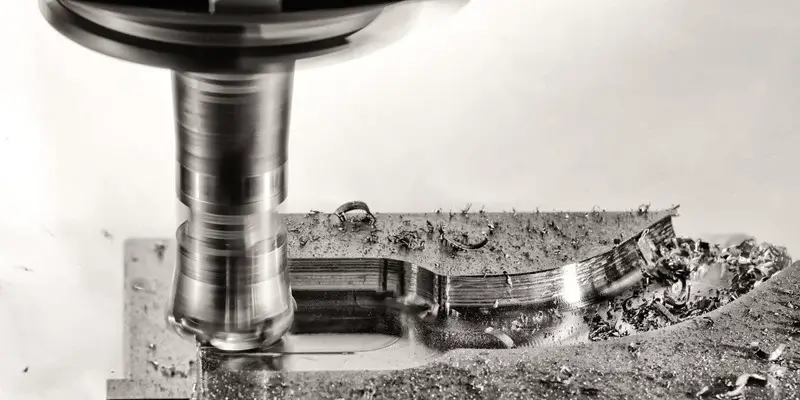
High-Speed CNC Milling
Shoulder milling is highly precise and provides a smooth surface finish, and is therefore used when the component needs to fit with an accurate fit. Its capability of penetrating the workpiece at variable levels enables flexible machining of complicated contours without tool instability.
The operation minimizes tool deflection, which minimizes the risk of damaging the workpiece and reduces the tool life. It is also efficient with a little heat production and can cut material fast with multiple cutting edges. In general, shoulder milling is economical because the tool life is longer, the number of tool changes is reduced, and less energy is consumed.
ProleanTech maximize these advantages with advanced CNC shoulder milling operations. ISO-certified services, high-performance machines, and experienced engineers ensure tighter tolerances, consistent quality, and faster turnaround for your projects
Is Shoulder Milling Expensive?
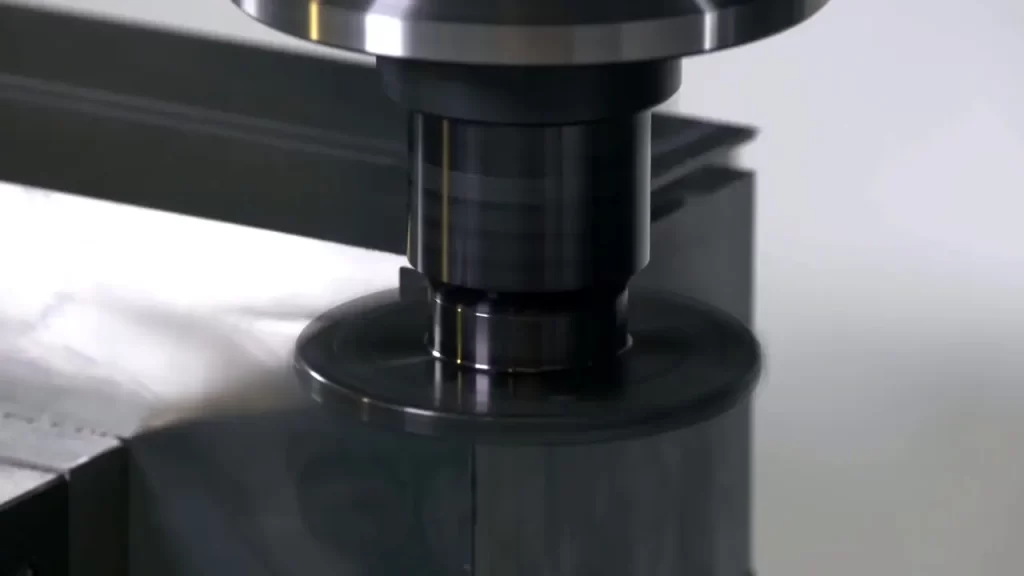
Square Shoulder Mil
Yes, it is true that shoulder milling is expensive compared to other forms of milling. The specialized cutters cost more due to their complicated design and quality materials. Installation may require more time, given that fine adjustment of the cutter is needed. Also, the machining is often performed with reduced feed rates and higher spindle speeds, which costs more.
Is Shoulder Milling Safe?
Shoulder milling is not harmful, provided that the necessary precautions are taken. Flying debris and clothes, hair, or jewelry being trapped in the machine are risks. In order to be safe, it is important to wear personal protective gear such as safety glasses and gloves, lock down loose objects, apply machine guards, and avoid moving parts. Knowledge and appropriate training are the primary elements of accident prevention.
What Are the Tips for Effective Shoulder Milling?
- Choose the appropriate cutter to use.
- Change cutting speed, feed rate, and depth of cut based on the workpiece.
- Checks regularly the cutter, trying to find wear or damage.
- Firmly clamp the workpiece.
- Apply lubricant or coolant to minimize heat and friction.
- Maintain the milling machine.
- Wear proper PPE.
- Develop a toolpath that has fewer engagements and enhances the removal of chips.
- Use chip-breaking tools or techniques.
- Removing excessive tool overhang will avoid deflection.
- Understand the material properties before milling.
- Plan to replace tools that are subject to unforeseen wear or failure.
- Make sure that the operators are trained and skilled.
- Keep the working area tidy.
Summary
Shoulder milling is a versatile machining operation in industries such as aerospace, automotive, mold and die-making, medical devices, and heavy machinery. It enables the production of vertical surfaces, slots, and intricate profiles with great precision and surface finish.
The key to getting the best results is choosing the appropriate cutter, being familiar with the workpiece material, and using correct machining techniques. Shoulder milling also enhances efficiency, minimizes tool deflection, and provides high-quality production on complicated parts.
Shoulder milling plays a key role in producing high-precision parts for industries like aerospace, automotive, and medical. At ProleanTech, we deliver ISO-certified CNC milling services with advanced machines, skilled engineers, and quick turnaround. Your parts will meet the strictest tolerances every time. Get a Quote to start your project today.

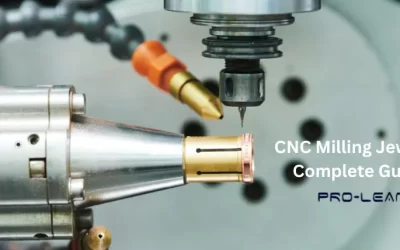
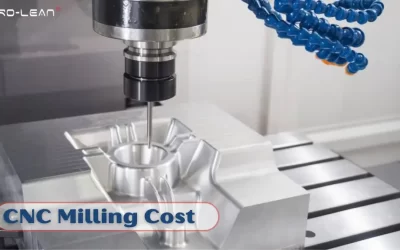
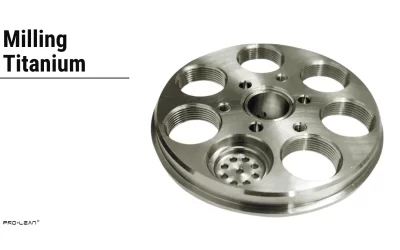
0 Comments